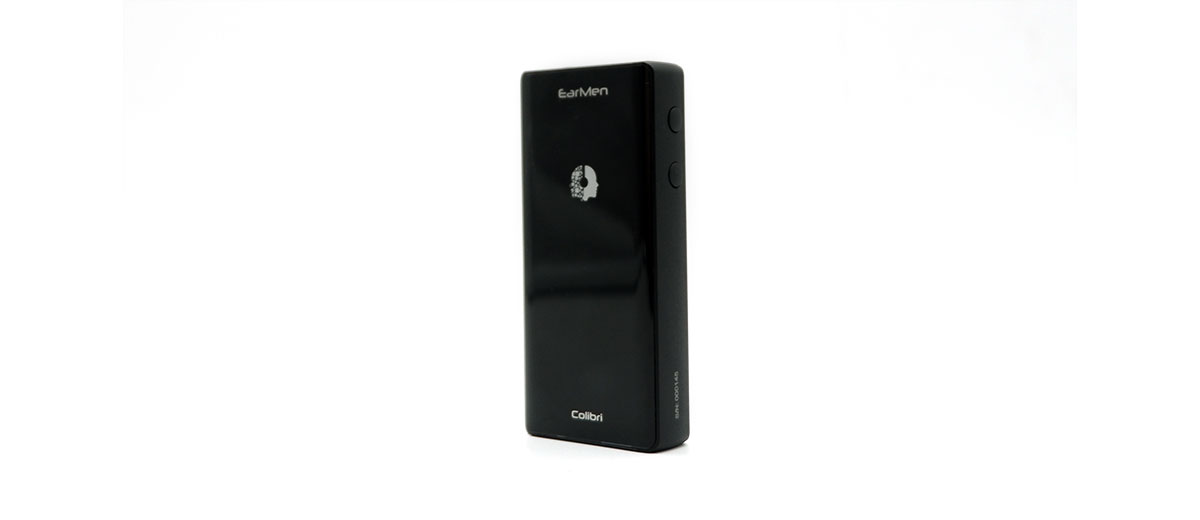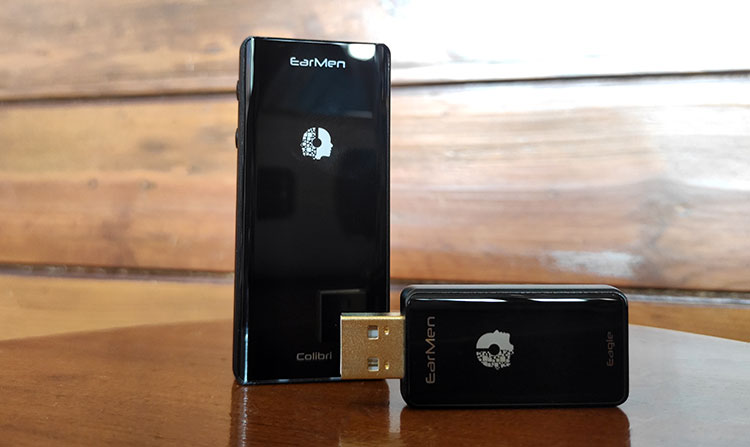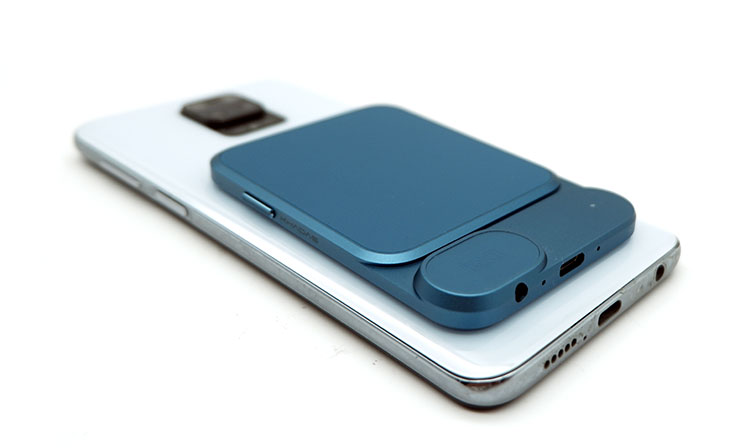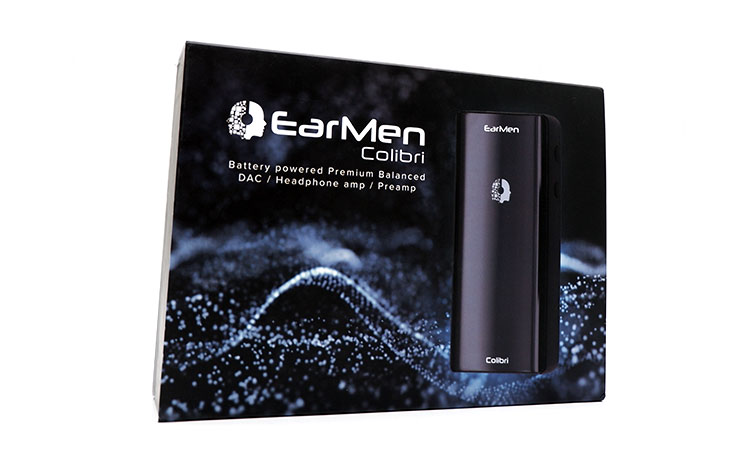Select Comparisons
Earmen Eagle
$129
Technical
Instead of running an ES9281PRO DAC, the Eagle uses an ES9280CPRO DAC chip. This means that most of the functionality is built into the DAC chip, such as a headphone output section, and even a USB controller.
However, the big difference is that the ES9280CPRO doesn’t have MQA decoding capabilities, but PCM decoding is left at 32BIT/384kHz while having DSD128 decoding capabilities as well.
Being a pure dongle DAC, the Eagle doesn’t have an internal battery, instead, it takes its power from the USB A port. Also, the headphone output section on the Eagle is limited to a 3.5mm single-ended output having even less rated power at 62mW into 32Ω.
Design
Physically, the 2 DACs have a striking resemblance, which really leaves no doubt that they come from the same stable. Both DACs have the same shiny front and back while having a matte black finish on the sides. However, the Eagle is a much smaller device designed to be a dongle. Thus, it looks more like a flash drive.
Aside from the much smaller footprint, the Eagle doesn’t have any buttons on the sides. Instead, it’s just a straightforward device with a single 3.5mm output that you can plug into any smartphone, PC, or MAC through the large USB-A port which makes it a comparatively less elegant solution, particularly with smartphones or tablets.
Performance
Both DACs come from the same company, which means that they would typically retain a house sound which manifests itself in how both DACs have a generally even-handed tonal balance with ample bass lift. The Eagle is outclassed by its stablemate in the amount of control that the DAC exerts over the driver, where it ends up being looser in the bass region.
Also, the treble on the Eagle ends up being more prone to being sibilant, particularly with tracks that already have natural levels of sibilance in them. Vocal tracks also tend to have a comparatively drier presentation with less euphony while vocal texture and nuance are a touch harder to notice.
On its own, the Eagle sounds spacious enough, however, listening to it together with its other stablemate, the Eagle ends up having a more intimate soundstage presentation. Images, on the other hand, end up blurring together as the space between each image isn’t as pronounced.
Earmen Sparrow
$199
Technical
A side-by-side comparison between the two DACs shows that they have a lot in common, which includes the same ES9281PRO DAC chip that both DACs use. This also translates to both DACs having the same decoding capabilities, which include MQA, DSD128, and PCD up to 32bit/384kHz.
Both DACs also have a balanced output, but the Sparrow has about half the power at 125mW into 32Ω while having closer power numbers through the single-ended output at 62mW into 32Ω.
However, the biggest change between the 2 DACs is that the Sparrow doesn’t have an internal battery. This in turn forces the Sparrow to rely on the stability of the 5V output of the upstream source instead of consistently having a tightly regulated power supply through an internal battery.
Design
Putting these 2 DACs side by side, the Sparrow simply looks like a shrunken version of the Colibri. So they both have the same shiny acrylic front coating and matte black metal sides. However, the Sparrow doesn’t have any buttons to speak of. Thus, labels at the rear of the device are less of a necessity.
The general position of the ports on the Sparrow is similar, but the Sparrow only has a solitary USB input port instead of having a separate port for charging/power. Then the balanced output on the Sparrow comes in the form of the much smaller 2.5mm output port. These factors contribute to allowing the Sparrow to have a much smaller footprint.
Performance
Having the same chipset and coming from the same company, the sonic characteristics of the 2 DACs end up being very similar.
Both have an even-handed tonal balance, however, the bass quantity on the Sparrow is in between having the bass boost on and the bass boost off on the Colibri. In my opinion, this is a safe way of tuning the Sparrow since it doesn’t have the option for the bass boost.
Another difference between the two DACs is that the Sparrow tends to lose out on overall detail retrieval because it needs to rely on the external power supply that may not be precisely regulated.
This leaves the Sparrow with a less textured and detailed midrange presentation while having most instruments take one step closer making the soundstage a bit smaller.
Interestingly, the Sparrow also has a touch more treble energy, making it a bit more engaging while seeming a bit more detailed. Fortunately, it doesn’t lead to the Sparrow tending towards sibilance, which allows the Sparrow to remain enjoyable.
Khadas Tea
$199
Technical
Both these DACs use the same ES9281PRO USB codec, which means that it’s an integrated circuit designed to have a USB input and even a headphone amp section. This results in both DACs having similar decoding capabilities, with both capable of MQA decoding as well as PCM 32/384kHz, but the Tea can do DSD256.
Interestingly, the implementation of the 2 companies is a bit different. Whereas Khadas opted to integrate Bluetooth connectivity into the Tea, the bass boost function is glaringly absent.
The headphone output to just a 3.5mm single-ended output, however, the power output for the single-ended port on the Tea produces more than double the output power at 160mW into 32Ω.
Design
Both DACs have quite a few similarities internally, but the external form factor of the two DACs gives away the intended purpose of each device. With the Tea being much thinner while being much wider, it’s obviously designed to be tucked away behind your smartphone.
Controls on the 2 DACs are also similar since both have a power button and volume rockers. However, the controls on the Tea surprisingly go beyond volume control.
The volume rocker can also be used to toggle charge control, so having a solitary USB C input becomes less of a disadvantage in terms of battery preservation. Also, the volume rockers can be toggled to work as the next track/previous track.
Performance
Having the same DAC chip doesn’t automatically equate to having the same performance, and the comparison between these 2 DACs is a perfect example of this. What’s most immediate is that the Tea has a comparatively brighter timbral tilt, while having a drier midrange presentation. However, this doesn’t equate to better detail retrieval, as the Tea is a shade less textured.
There is also an evident reduction in control over the driver, particularly with the bass region, as bass notes aren’t as tight or textured. Cymbal hits on the other hand have a splashier quality making each cymbal hit sound like it’s blurring into the rest of the frequency spectrum.
While the soundstage can be wide on both DACs, the soundstage on the Tea is a bit more intimate resulting in the images taking a step closer to your when listening. Also, the images blur together a bit more since they are less defined.
Our Verdict
The new Colibri is unmistakably part of the Earmen portable DAC lineup, taking design cues from both the Eagle and the Sparrow.
However, the Colibri is designed to have an internal battery for a more stable output voltage which comes at the cost of having a larger form factor which might make it more difficult to let it dangle from your source, thus making it a bit more cumbersome as a portable solution.
With the more stable power source through the internal battery being one of the bigger features of the Colibri, it comes as no surprise that the Colibri can create an impressive sense of scale, space, and nuance.
While having a neutral tonal presentation typically makes for a less engaging experience, the nuance and scale of Colibri’s presentation make for an overall engaging experience in a portable package.
Earmen Colibri Specifications
- Input: USB C Female (DATA, Charging)
- Output: 4.4mm, 3.5mm jack
- Balanced: Up to 280mW@32Ω / 560mW@16Ω
- Unbalanced: Up to 75mW @ 32Ω, 150mW @ 16Ω
- Battery: Up to 5 hrs
- THD+N: 0.002% balanced, 0.001% unbalanced
- Frequency Response: 0.09dB
- DSD: 64 / 128 DoP
- DXD: 64 / 128 DoP
- PCM: Up to 384 kHz
- MQA Rendering: Up to 384 kHz
- Dimensions: 77 x 35 x 14mm (L x W x H)
- Battery: Up to 5 hours
- Weight: 51g





